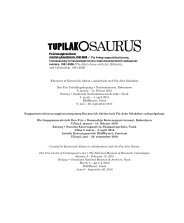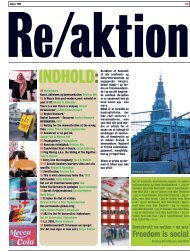tupilakosaurus - Print matters!
tupilakosaurus - Print matters!
tupilakosaurus - Print matters!
Create successful ePaper yourself
Turn your PDF publications into a flip-book with our unique Google optimized e-Paper software.
gata pissaanera erseqqissaqqippaa.<br />
Inuup nunatallu imminnut<br />
taartigiiaarnerat, inooriaatsip<br />
nunasiallu akornanni, taamaallaaterseqissarneqarsinnaanngilaq<br />
nunap timitaqanngitsumik<br />
pilikki atorlugu pappialamut<br />
titartaanikkut, kisiannili isummamigutallangoriataallaqqissumik<br />
aattaqartumillu sippoqarpoq<br />
kaffinik, taratsunik, sukkunik,<br />
qaqorteqqasunik il.il.; nioqqutissanik<br />
pigisanillu paarlagaanneq,<br />
nunasiap ulluinnarni atugaraa<br />
atortarsimallugulu, minnerunngitsumillu<br />
nunarsuarmi politikkip<br />
aningaasarsiornerullu atuutinnerinut<br />
tulluuppoq. Legende-mi<br />
Arkep iluatsippaa naalaarluarluni<br />
misiginneqatiginnillunilu nunap<br />
assingata timitaqanngitsup paasisallu<br />
titartarnerat qaangerpaa<br />
ulluinnarni inuunerup ilungersunartup<br />
ilanngunneratigut. Soorlulusooq<br />
nunataq inunnit tassani<br />
suli inuusunit nassuiarneqarsinnaallunilu<br />
allamik nassuiaaseqqinneqarsinnaasoq.<br />
Tassuunarpiarlumi Legende-p<br />
eqquissumik ataqatigiissilerpai inuup<br />
ataatsip kinaassutsiminik inuunerminilu<br />
ilikkakkamigut qamani<br />
pigisai nunarsuarmilu politikki,<br />
nunap assiliaq, nunatamik killiliisoq,<br />
ataatsikkut ilivitsunngortillugit,<br />
sunniisinnaanngorlugit inuillu<br />
inuuneri nutaamik paasineqarsinnaasunngorlugit.<br />
Jan-Erik Lundström<br />
Pia Arke. Legend I-V. 1999<br />
The title of this series of<br />
works, Legend (in Latin<br />
“legenda” = things to read,<br />
in English “legend” = story,<br />
caption, inscription, explanation<br />
of symbols on a<br />
map), reminds us of the<br />
fact that a map is always<br />
something more than and<br />
different from a simple<br />
and immediate and given<br />
picture of a territory. Rather<br />
than imitating or reproducing<br />
the territory, the map<br />
commands and defines the<br />
territory it depicts. Perhaps<br />
one could even say that the<br />
map creates the territory.<br />
Before the map’s intervention<br />
there were no borders,<br />
no outside and no inside, no<br />
my and no your territory.<br />
After the map’s intervention<br />
the contours of the territory<br />
have been carved in stone,<br />
places have received new<br />
identities, landscapes have<br />
been coloured and living<br />
spaces fenced in.<br />
In the five collages of maps,<br />
photographs and other<br />
material that constitute<br />
the series Legend Pia Arke<br />
contrasts the colonial map<br />
– the map that was drawn<br />
by the coloniser’s cartographers<br />
– with the presence of<br />
individuals. Here, in the territory,<br />
there are, there live<br />
individuals. A human being<br />
seen through a photographic<br />
portrait placed in the middle<br />
of the map, visualises the<br />
map’s ambitions: to identify<br />
and fence in people’s everyday<br />
lives, to colour and<br />
define their goals.<br />
But Legend rearticulates<br />
the power of the map in<br />
more than one way. The<br />
exchange between man and<br />
territory, between life-world<br />
and colony, was not only<br />
characterised by an abstract<br />
cartography but also derives<br />
its strength from a material<br />
economy. That is why<br />
the maps in Legend are not<br />
just geometries of ink on<br />
paper, but temperament-<br />
and blood-filled remains<br />
of coffee, salt, sugar, rice,<br />
etc.; the exchange of goods<br />
and things that constitutes<br />
and constituted the daily<br />
life of the colony and, not<br />
least, its geopolitical and<br />
economic raison d’être. In<br />
Legend Arke has succeeded<br />
with sensitive empathy<br />
in overlaying the abstract<br />
geometry and empiricism of<br />
the map with the lived toil<br />
of daily life. And with hope.<br />
As if it were still possible for<br />
the territory to defined and<br />
redefined by the people who<br />
live there.<br />
It is exactly in this way that<br />
Legend so precisely unites<br />
life experiences rooted in<br />
personal biography with<br />
geopolitics; how the small<br />
strokes of the pen – which<br />
change a map, a map picture,<br />
and which draw in a<br />
territory – can completely,<br />
at one and the same time,<br />
affect and redefine people’s<br />
lives.<br />
Jan-Erik Lundström<br />
49




